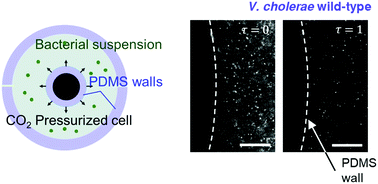CO2-Driven diffusiophoresis for maintaining a bacteria-free surface†
Abstract
Dissolution and dissociation of CO2 in an aqueous phase induce diffusiophoretic motion of suspended particles with a nonzero surface charge. We report CO2-driven diffusiophoresis of colloidal particles and bacterial cells in a circular Hele-Shaw geometry. Combining experiments and model calculations, we identify the characteristic length and time scales of CO2-driven diffusiophoresis in relation to system dimensions and CO2 diffusivity. The motion of colloidal particles driven by a CO2 gradient is characterized by measuring the average velocities of particles as a function of distance from the CO2 sources. In the same geometrical configurations, we demonstrate that the directional migration of wild-type V. cholerae and a mutant lacking flagella, as well as S. aureus and P. aeruginosa, near a dissolving CO2 source is diffusiophoresis, not chemotaxis. Such a directional response of the cells to CO2 (or an ion) concentration gradient shows that diffusiophoresis of bacteria is achieved independent of cell shape, motility and the Gram stain (cell surface structure). Long-time experiments suggest potential applications for bacterial diffusiophoresis to cleaning systems or anti-biofouling surfaces, by reducing the population of the cells near CO2 sources.



 Please wait while we load your content...
Please wait while we load your content...